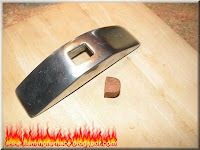

As for the ingot container any metal container is good depending how big you want the ingot to be, don't forget it has to be fitted into the crucible.
Big aluminum parts could be broken with a heavy hammer so they will fit into the crucible. Another option is heating the aluminum parts in an open fire until the aluminum is soft enough to be broken easily.




Another very important thing is always work with a dry ingot container and preheat the container before pouring the molten metal to prevent it from "poping" into your face and of course use full body protection gear while handling molten metal. I made a few large ingots using simple tin cans. It is very easy to cut them open in one vertical slice and after just to peal the sides off. Gloves are good to have to prevent cuts from the sharp edges.



Simple example for making a re-usable ingot tray is to weld a few L bars together or just using a tin muffin tray (Not aluminum). It all depends on what size of ingot is desired and how much molten metal is going to be poured into ingots.





Before you know it you will have a pile of aluminum ingots ready for some quality sand casting............ Good luck... and work safe ;-)
First clip pouring round aluminum ingots:

 <---Aluminum ingots
<---Aluminum ingots Second clip pouring long and slim aluminum ingots:





















